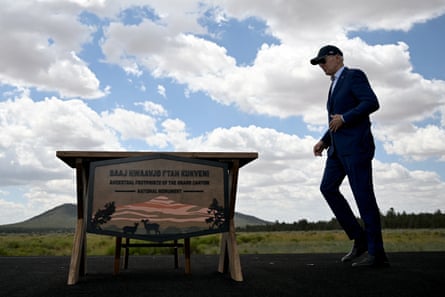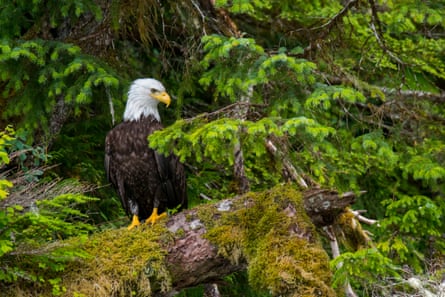‘America the beautiful’: how Biden is conserving land and water as Trump looms
A week after his presidential inauguration, Joe Biden cited the climate and biodiversity crises as reasons to set a sweeping new goal – to conserve at least 30% of America’s vast lands and waters by the end of the decade.
Three years on, new protections have spurred meaningful progress towards meeting the target by 2030.
Those efforts stretch from glacial lakes in Minnesota to tribal lands in arid New Mexico to huge expanses of the frigid Arctic and to archaeological sites on the doorstep of El Paso, Texas.
However, the potential return of Donald Trump to the White House now looms ominously over hopes to preserve further land and seascapes.
What has Biden achieved so far?
As Biden took office, about 12% of US land had been protected by previous administrations.
About 41m acres, an area slightly larger than Florida, has been placed under some form of new protection across public and private lands during Biden’s term, according to the White House, meaning that about 13% of the US’s landmass is now deemed protected, up by about 1%.
A far smaller expanse of US waters have been newly conserved under Biden but the aquatic side of the goal is closer with 26% currently protected and with new designations planned for territories in the Pacific Ocean set to push the total above the 30% target.

The US is on track to meet the goal, known as 30×30 or America the Beautiful, the White House has insisted, which it says makes Biden a historic conservation leader. “President Biden laid out the most ambitious land and water conservation agenda in American history, and he is delivering, already cementing a legacy as one of the nation’s strongest conservation presidents,” said Brenda Mallory, chair of the administration’s Council on Environmental Quality. “He is standing up to protect places that are simply too special to develop.”
The global impact
Biden’s embrace of 30×30 has resonated globally, according to Sally Jewell, who was secretary of the interior under Barack Obama. Scientists have long advocated the need to set aside large areas from development to buffer against an unfolding extinction crisis and global heating – the biologist EO Wilson suggested half of the world be protected in this way – and, in 2022, governments agreed at a United Nations gathering to collectively embrace the 30×30 target.
“By doing this, the US has made a huge impact on the narrative of conservation in countries around the world,” said Jewell. “Thirty per cent isn’t a magic number, it’s maybe a data point in a journey, but it’s provided something important to rally around.
“We are on a pretty devastating trajectory with our ecosystems and climate change and 30×30 is something people can wrap their heads around. The goal is a high bar, it will be hard work, but tremendous progress has been made.”
What would a Trump win in November mean?
With at least half of the land-based goal still unfulfilled, the 30×30 target could be derailed should Trump win the presidential election in November. The presumptive Republican nominee has vowed to unleash a wave of new oil and gas drilling and, when previously president, opened up new areas, including the Arctic, for the fossil fuel industry.
Trump also took the unprecedented step of shrinking national monuments, which are protected places that a president has unilateral powers to designate, when he slashed the Bears Ears national monument in Utah by an enormous 85%, and the Grand Staircase-Escalante national monument, also in Utah, by nearly half in 2017.
A policy blueprint laid out for a potential new Trump term, called Project 2025, stipulates that the president should scrap the target and “eliminate management decisions that advance the 30 by 30 agenda”, complaining that it unfairly removes lands from industrial activity.

“If we spend another four years going in exactly the wrong direction on conservation, it’s hard to imagine how we would realistically reach the 30×30 goal,” said Dan Hartinger, senior director of policy advocacy at the Wilderness Society Action Fund. “We would fight that agenda from Trump and his fossil fuel allies but I’d rather we not have to. The stakes for the election are high.”
Do experts think the 30×30 goal is helpful?
The 30×30 framework itself has been somewhat contested from the start, over what counts as protected, how success is judged and questions over the rights of Indigenous stewardship. For some experts, sheer volume of protected land isn’t itself the key metric, given that a tiny urban park or a modest site with great cultural meaning may provide more benefits than adding a much larger area to an already-protected wilderness.
“I think it’s a good conversation starter,” Christoph Nolte, a conservation expert at the Boston University, of the 30×30 goal. “But the deeper reasons for why we’re doing this and whether we are moving in that direction, I think, are the ones that we should really be after.”
The Biden administration has identified climate change, protecting wildlife habitats and corridors and bringing more space to “nature-deprived communities” as its core mantras, and many of its actions have involved undoing Trump’s own policies.
A total of 10 national monuments have been created, restored or expanded, including re-establishing the original boundaries of Bears Ears, Grand Staircase-Escalante and a further marine monument, off the New England coast, that was reduced by Trump. New monuments range from the nearly 1m acres of tribal land abutting the Grand Canyon, to a much smaller five-acre site in Mississippi that honors the memory of Emmett Till.
In Alaska, 9m acres of the huge Tongass national forest have been deemed off-limits for new roads, overturning a Trump order, while another 13m acres of the remote western stretches of the state and 3m acres of the Arctic Ocean have been safeguarded from oil and gas drilling.
A new conservation district near the Everglades, meanwhile, will help protect species such as the black bear and Florida panther, a half-million acre chunk of Nevada that contains Joshua trees and gila monsters is now protected and Biden has signed off on nine other conservation areas passed by Congress, mainly in western states.
Many of these places have resonance beyond their mere acreage. “Bears Ears holds deep spiritual and cultural significance, and is rich in ancestral history,” said Craig Andrews, vice-chairman of the Hopi Tribe and co-chair of the Bears Ears Inter-Tribal Coalition. “The entire landscape contains countless cultural belongings that are vital to preserving our life-ways as Hopi people.”

Trump could reverse much of this but Biden has attempted deeper-rooted changes that the administration is confident will endure, such as the recent move to place conservation as an equal priority with activities such as grazing and mining on areas overseen by the Bureau of Land Management, which manages 245m acres of territory, mainly in the US west.
The shift away from seeing public lands as just places to exploit by industry will “restore balance” and help fight the climate crisis, according to Deb Haaland, the interior secretary. The move opens up a path to conserve at least 30m acres of prime ecosystem habitat on BLM land, according to Hartinger, who called it a “massive cultural change” in the way public lands are viewed.
Republicans are far less keen. “With this rule, President Biden is allowing federal bureaucrats to destroy our way of life,” said John Barrasso, a Wyoming senator who has vowed to repeal the new plan. If Trump wins power in November, he will probably have presidential support in this.
How much US land does the federal government control?
Conservation doesn’t rest entirely with the federal government, which oversees about a third of all the US’s land. The rest, divided among states, tribes and private owners, will still have various protective initiatives regardless of the election, with money from legislation such as the Inflation Reduction Act helping fund projects that help prevent clearing of certain forests or filling in of wetlands. About 5m acres of private land has been protected since Biden took power, some using federal assistance.

Jewell, the former secretary for the interior under Obama, said she was confident Trump would not halt this conservation work, which is just as important for its quality as for its mere quantity. “30×30 is a catchy phrase but not all acres are created equal – protecting high alpine rocks isn’t as valuable as protecting wetlands that are critical habitat for wildlife,” she said. “Biden has made good progress in unlocking money for conservation on private lands, and is targeting the right places for that.”
After leaving her position as interior secretary, Jewell took a road trip with her husband to stop off at some of the wildlife refuges and conservation areas that dot the US, many far smaller than the stunning, sprawling monuments and national parks that grip the public imagination.
“We’d take a handbrake turn as soon as we saw a brown sign and go to these small pocket wildlife refuges,” she said.
“Many people would say why save these, there’s nothing there. But if you’re an animal, a migrating bird or a monarch butterfly perhaps, they are critically important oases as you’re flying overhead of all this nonsense from humans. They are postage stamps of land, but vital postage stamps.”
Source: theguardian.com
